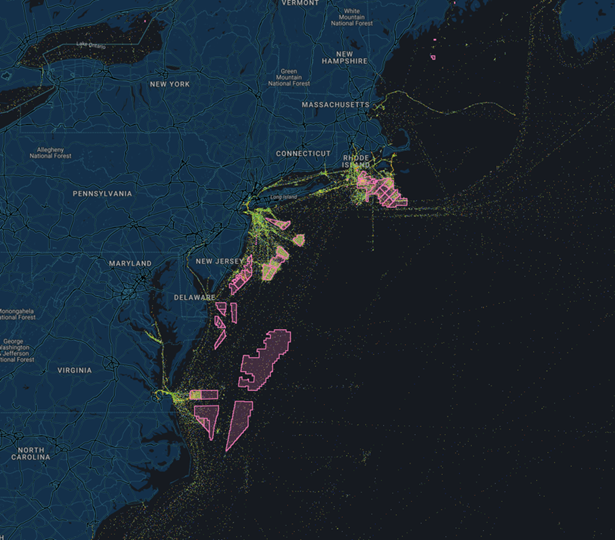by David Matthews, Head of Strategy, Clarksons Offshore

The US offshore wind sector is on the rise, poised to become a major player in the global offshore wind industry. Projections indicate remarkable growth, with the potential for 23 GW of installed capacity by 2030 across 28 wind farms and approximately 1,600 turbines, a significant increase from the current 42 MW (2 wind farms and 7 turbines). The image above displays shipping activity around key East Coast projects over the past 4 months - an Offshore Wind Vessel Heat Map.
Developers have proposed a staggering 45 GW of offshore wind capacity in the US, with a significant focus on the East Coast, including 11 GW off New York and 9.2 GW off New Jersey.
The US wind "fleet" currently comprises 25 vessels, primarily repurposed from oil and gas assets. However, limitations in US shipyards and competition for yard space present potential bottlenecks for US offshore wind expansion.
It's no secret that there are issues in the US, as Orsted announced a $2 billion write-down due to setbacks in its US portfolio. This underscores that even the most experienced developer can encounter problems when venturing beyond local waters into new territory. We want to avoid appearing overly optimistic about US offshore wind, as we recognize that this news may shake investor confidence, which will take time to rebuild. Delays in wind projects can be costly and impact cost-out figures and IRR.
I've asked Olivier Candeel, our T&I Transport Manager, to shed some light on this based on his experience and recent interactions with OEMs, developers, and contractors in the US.
"In recent years, we've witnessed offshore construction projects taking off in new regions beyond the European continent where we have become accustomed to building offshore wind. After witnessing multi-scale projects in Taiwan, the spotlight is now on the United States. These endeavours provide the industry with numerous valuable lessons for the new generations of offshore wind projects to come.
In well-established regions like the North Sea, practices such as Management-of-Change procedures and Variation Orders are standard protocol, and for good reason. However, when stakeholders venture into new territories with less developed infrastructure, limited vessel availability, and evolving local regulations, finding creative solutions to keep projects on track becomes a challenge, as demonstrated by Orsted's recent announcement.
Currently, in the USA, the industry is breaking new ground, both literally and figuratively. Developers and T&I Contractors are pioneering unconventional methods to turn offshore wind projects into a reality. They're embracing Canadian marshalling ports for foundations, navigating the intricacies of the US Jones Act with specialized barges and tugs, employing advanced motion-compensated sea fastening systems, and utilizing US feeder and secondary work support ports.
Each of these new elements is intertwined, and a hiccup in one part of the process can have a cascading impact on the entire project. Add to that the challenges of working on the East Coast, with its unique mix of curious marine life and ever-changing weather forecasts, and you have a recipe for complex offshore operations and delays.
So, for anyone who might assume that all of this is a walk in the park, I encourage you to think again. Offshore construction in emerging regions demands ingenuity, adaptability, and a relentless commitment to overcoming obstacles. Even the best can encounter challenges, and success depends on how the team reacts to these changes and overcomes them".
At Clarksons, we understand the intricacies of the offshore wind industry, and we're here to support the US offshore wind sector in finding innovative solutions to get the job done. Our US-based team is at your disposal, and we're dedicated to helping you overcome these challenges.
The Clarksons team is already actively engaged in supporting both Vineyard and Southfork with various vessel requirements and contingency plans should delays affect the next phases of those projects.
Feel free to reach out to Frederik C. Andersen (Oslo), Jonathan Lints (Houston), or Olivier Candeel (Edinburgh) for assistance.
KeyFacts Renewable Energy Directory: Clarksons Offshore & Renewables
 KEYFACT Energy
KEYFACT Energy